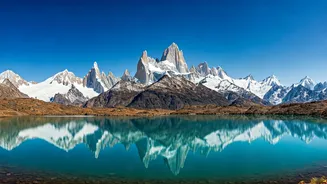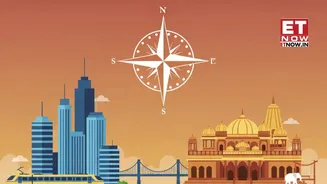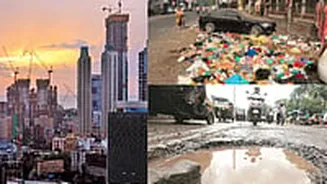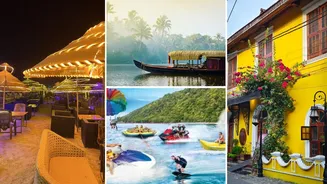What is the story about?
Rangareddy district in Telangana has emerged as India’s richest district by GDP per capita, according to the Economic Survey 2024–25. With an impressive
GDP per capita of approximately Rs 11.46 lakh, the district represents how urban spillover and economic diversification can transform local economies. As per a TOI report, the survey also showed other top-performing districts including Gurugram, Bengaluru Urban, Gautam Buddh Nagar, Solan, North and South Goa, several districts in Sikkim, Dakshina Kannada, Mumbai, and Ahmedabad, each contributing uniquely to India’s evolving growth story.
Rangareddy, Telangana — Rs 11.46 lakh
Topping the national chart, Rangareddy stands as a testament to how metropolitan expansion fuels prosperity. The district has thrived on the back of the IT sector, biotech and pharmaceutical industries, and state-of-the-art tech parks. Improved infrastructure and connectivity have only accelerated its growth. Beyond its economic power, Rangareddy balances modern urbanity with scenic calm, offering tranquil escapes like Osman Sagar Lake and the lush Ananthagiri Hills.Gurugram (Gurgaon), Haryana — Rs 9.05 lakh
Synonymous with corporate culture and high-end living, Gurugram boasts luxury malls, fine dining spaces, and towering skyscrapers. Despite its modern vibe, the nearby Sultanpur National Park offers nature lovers and birdwatchers a peaceful weekend retreat, especially during the migratory bird season.Bengaluru Urban, Karnataka — Rs 8.93 lakh
Often called India’s “Silicon Valley,” Bengaluru merges cutting-edge technology with timeless greenery. The city’s colonial charm at Cubbon Park, its bustling café culture, and sunrise treks to Nandi Hills make it a city where innovation and leisure coexist harmoniously.Gautam Buddh Nagar (Noida), Uttar Pradesh — Rs 8.48 lakh
Home to futuristic infrastructure and vibrant cultural spaces, Gautam Buddh Nagar reflects modern India’s dynamism. Visitors can enjoy the thrill of Worlds of Wonder amusement park, find peace at the Okhla Bird Sanctuary, or indulge in shopping across its sprawling malls.
Solan, Himachal Pradesh — Rs 8.10 lakh
Nestled in the Himalayas, Solan is admired for its serene landscapes, mild climate, and spiritual charm. Known as the “Mushroom City of India,” it attracts travellers with natural spots like Karol Tibba and the revered Shoolini Mata Temple.
North & South Goa — Rs 7.63 lakh
The twin districts of North and South Goa continue to enchant tourists and locals alike. While North Goa pulses with nightlife and beach parties, South Goa offers quiet stretches of sand and scenic peace — together embodying India’s most beloved coastal contrast.
Sikkim (Gangtok, Namchi, Mangan & Gyalshing)
Sikkim’s high-ranking GDP per capita underscores the strength of sustainable tourism and local enterprise. The state’s Himalayan beauty is dotted with monasteries, vibrant markets, and natural wonders like Tsomgo Lake and Nathula Pass, making it a traveller’s paradise with economic potential.
Dakshina Kannada (Mangalore), Karnataka — Rs 6.69 lakh
A melting pot of Portuguese, Tulu, and Konkani influences, Mangalore mesmerises with its golden beaches and centuries-old temples. Attractions such as St. Aloysius Chapel and Panambur Beach reflect the district’s cultural depth and coastal charm, while its spice trade and industries boost local wealth.
Mumbai, Maharashtra — Rs 6.57 lakh
India’s financial capital, Mumbai, stands as the heart of business, Bollywood, and heritage. With landmarks like the Gothic Chhatrapati Shivaji Terminus and the sunset hues of Marine Drive, the city captures the unending spirit of hustle and hope.
Ahmedabad, Gujarat — Rs 6.54 lakh
As India’s first UNESCO World Heritage City, Ahmedabad seamlessly fuses its Mughal past with a progressive present. From the architectural beauty of its mosques to the modernity of Sabarmati Riverfront, the city reflects India’s growth and global ambition.
These emerging economic hubs mark a defining chapter in India’s development, where technology meets tradition and regional strengths align with national aspirations. Together, they represent a future driven by innovation, inclusivity, and balanced urban expansion.
(The GDP figures and ranks mentioned are based on the Economic Survey 2024–25, summarised from multiple media reports.)
Do you find this article useful?


















